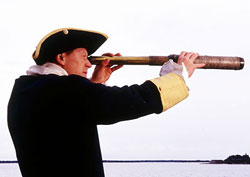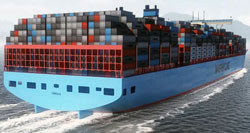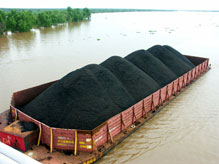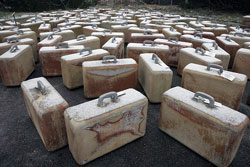| |
Issue 9 : October 2011 |
Almost on schedule a quarterly newsetter! It has been a long summer, listening to the news of crisis and volatility has been juxtaposed with seeing my daughters leave home to futher their education and the company being frighteningly busy.
All of this has provided some mental dissonance and that has perhaps led to a newsletter that has a bit of a broader sweep, starting off with a contribution to the Envrionment. It does no long term favours to the Envrionment if ideas and solutions are not checked throguh properly and challenged occasionally. A rigerous process will improve the future for all, so lets try and see through the bull to look after the Environment. |
 |
Taking as a theme the idea of looking through the bull to the reality, we also take a look at a new service offerings from the premier container line, leading the way forward in how we manage ourselves and create value? There is also some talk about creating value or reclaiming value from Indonesian coal and a little bit of blue sky thinkingn for the cruise sector. Hope you enjoy it all and as always it will be interesting to get your feedback on our opinions and comments in this newsletter, just contact me on [email protected] |
The Environment: Too important to Bullshit about
“Taking sustainability as an important aspect of competition,” so read the port magazine. Is the need to imitate Kermit the frog in “Being Green” getting the better of common sense? Let us face it, which shipping company is going to make a decision to use a port because it is green despite the
fact
that
 |
|
it is 100km off the right location? Reading the supporting articles within the magazine the essence of being green seemed to be filling in the right forms, ticking the right boxes and ensuring you have the right policies (and the badge or symbol to prove it!). There are a few things that a terminal can really do to improve (assuming you are well managed in the first place). LED lighting would be one example that works and cuts down your power consumption; not sure about the overall environmental impact though because LEDs are not the most |
environmentally friendly thing to make so overall, are we sure the net benefit is there? Or even with that have we just ensured that someone else has the problem of how to reframe their business to become green?
Do any of us seriously expect a port to be able to save enough money from environmental initiatives to enable them to win business from competitors through the scale of the eco-discounts? Or are Port Authorities indulging in a sly bit of image building that covers the provision of subsidies that perverts the economic logic of where and how cargo should be handled to achieve the lowest cost; which most often means the shortest most efficient transport distance from the single most environmentally and energy efficient form of transport the world has and has even known, let us hear it for, shipping.
So, when the environment is talked about so easily as being an important aspect of competition or initiatives are taken that seem to rely more on their sex appeal (and presumably their ability to burnish someone’s image) we should all step back, be more cynical and ask why are things happening. Perhaps we should all think much more carefully about being green, see the big picture, realise that understanding that picture is very, very difficult and instead of being sucked in to the latest trend, work out how each of us needs to change our own habits and action if the people of the world has any hope of becoming less damaging to the beautiful biosphere that keeps us all alive.
Product Development in Container Shipping
 |
|
Maersk’s announcement was bold, it was flashy, it was loud, “The Daily Maersk”. See even I can remember the tag line! But what did it actually mean? As one journalist from the maritime press put it, they mainly repackaged existing services and offered a guarantee that meant they promised to deliver a quality of service rather below their existing scheduled performance. Alphaliner highlighted that Maersk could have offered a 32-day |
transport time from Shanghai to Rotterdam rather than the promised 34 days. So with my cynical engineer’s hat on, this is all just marketing bullshit associated with appointing a former head of Carlsberg to run a shipping line. At one level there is truth in that accusation. However, I remembered the tag line, “The Daily Maersk”. How well will that stick with shippers in their target market? Will the shippers (and more particularly the juniors and booking clerks) see this as value addition? Moving more to the DHL guaranteed next day delivery and away from an attitude where sometimes shippers are wondering who pays the piper because their box is not where or when they want it… The thinking and effort put into this product is a symptom of Maersk thinking differently. More like a service company who believe that how they sell themselves is as important as the mechanics of the service they provide. Many of us spend so long dwelling on the size of the ships, the speed of the cranes, the routing structure for strings of ships that little time is left to consider how the people who pay all our wages see the service provided. The new thinking applied by Maersk may just be the tip of the iceberg as more industrial approaches to organisation and management move into an industry that too often appears to believe that the maritime sector has to be all about the ships and the ports. It is an industry that has to provide a service. If we want people to pay more, maybe we have to give them a better service or a better product? I am sure many in the cruise sector would agree with that; product differentiation is a critical part of how they compete. Perhaps Maersk is on its way to becoming the 6* container line or the DHL of the waves. Maybe “The Daily Maersk” is their way of packaging tap water and charging us US$5 a bottle for the pleasure of drinking it!
News Item: Indonesian Conference
 |
|
In February DWA will be presenting at a conference in Jakarta. This is mentioned because if you want to know about ports and terminals in Indonesia, the problems, the opportunities, the successes and the failures, this has the best line up of speakers I have ever seen. The details can be found on the IQPC web site. It is in my diary for 20th and 21st February, conveniently |
after the Chinese New Year! The eagle eyed among you will spot that DWA are cooperating with Rothschild on a workshop during the conference; that should be fun, for me if for no one else!
Indonesian Coal and Increasing its Value
Did you know that coal out of Indonesia is currently being sold well below world market rates? The discount is at time as high as 30% but most of the time it hovers around the 15 to 20%. So, over a year, that may be worth in the order of US$ 2.5 to 3.0 billion on exports of two hundred million tonnes of coal and that is most likely to undervalue the loss. Why should this be the case?
Key reasons for the loss of value include: |
|
 |
 |
Indonesian mines find it difficult to maintain consistency of specification because of a lack of ability to consolidate and blend the different coals they produce to a set specification. This is mainly because of a lack of consolidated stock piles and blending opportunities within the transport chain |
 |
A lack of penetration from coal trading companies into the Indonesian market place to “make” the market and blend coal. This lack of penetration is linked to the lack of accepted benchmarks and the ability to deliver coal to set specifications |
 |
The level of direct contracting and an associated lack of transparency between seller and purchaser in Indonesia |
Through the creation of the ICI index, the Government of Indonesia has started to address this value discount by setting clear specifications for Indonesian coal and seeking to develop it as a tradable commodity. It certainly is easier now to know how big the discount is! However, because the consistency of specification for the coal being exported is a key issue for the buyers, perhaps the key underlying reason for the loss of value is the first one. Buyers cannot be sure at time of the purchase of the “real” specification of coal they will have delivered. Particularly when coal is moved from the mine in barges and transhipped at sea there are problems ensuring a specification is met.
A single mine can improve this if they can blend properly from their own stocks or with coals from other mines. This is the holy grail of the large coal terminals that have been proposed. Providing Indonesia with the capability offered by Richards Bay in South Africa or Dalrymple Bay or Newcastle in Australia where the terminals act more like a wholesale coal market than simple coal terminals. A good terminal, well planed (physically and commercially) should be able to sell at US$ 44/t what they sell today for US$ 36/t. An example calculation would be based on the graphs below which show the differential of ICI standard to similar coal ex-Richards Bay and ex-Newcastle. So ICI 5,800 kCal Coal is currently priced about US$ 100 adding the ability to meet specification as effectively the price will rise a minimum of 10 to 15%. Consequently, this price rise for this coal will be between US$ 10 and 15/t. Therefore the terminal itself should be able to create substantial value by raising the sale price achieved by the mines. Perhaps, at this time, more imagination and cooperation is required from the mines and those seeking to develop terminals to grasp the value that is being lost to Indonesia.

Baggage Handling and Styling a Cruise Facility
 |
|
State of the art baggage reclaim for cruise terminals. The English translation of that, perhaps, should read a better system of putting people’s bag on the ground in a big hall with big signs around. So where are the brave terminals who could implement some real innovation?
New tracking technology can exist to ensure that within an Intelligent Cruise Terminal you could know where each bag is at any time. The ability to track people in a relatively enclosed area has been around in several |
forms for many years so why not marry the technologies together and ensure that the bags can match themselves to people quickly and effectively?
As ever, the check in process would be easier than the reclaim process. It would be relatively easy to take the bags at the kerb or coach park register them using smart tags placed on them by passengers (sent by mail) or by kerb side staff. That association would allow sorting and delivery to the right cabin relatively easily.
The baggage reclaim process could be based on the process being worked in reverse with smart tags being used on luggage collected from cabins. Then passengers could then be provided a small hand held device to take them to their baggage in the hall. Alternatively, passengers could be tracked through the hall and the bag brought to them as they move towards their taxi, car, coach... maybe that is a step too far for the big ships, 4,000 passengers would need a lot of baggage staff! But for the smaller ultra luxury ships, why not?
Perhaps it is not the terminals that lack the imagination or the technology, but the cruise lines who use so many terminals that one clever terminal could even be more of a problem than a solution. They after all need a standard solution at each port of call. With thought it should not be that difficult to set these types of systems up on board the ships themselves with the readers and displays provided to the terminal on arrival. Anyone interested in talking DWA are available to discuss innovation and new approaches at anytime.
Seaport Group on Safari!
 |
|
After an absence of a few years it was nice to be back working in Africa in October; a lovely job on a coal terminal. This work was also a good example from the Seaport Group to which we are committing our consulting operations going forward. Experts from Singapore, Australia and the United States converging to give clients access to a unique blend of skills and experience. The ability to work 24/7 round the globe |
didn’t hurt either! Look for more involvement from us with Seaport as we develop our membership of the team and represent them in Asia in the coming years.
|